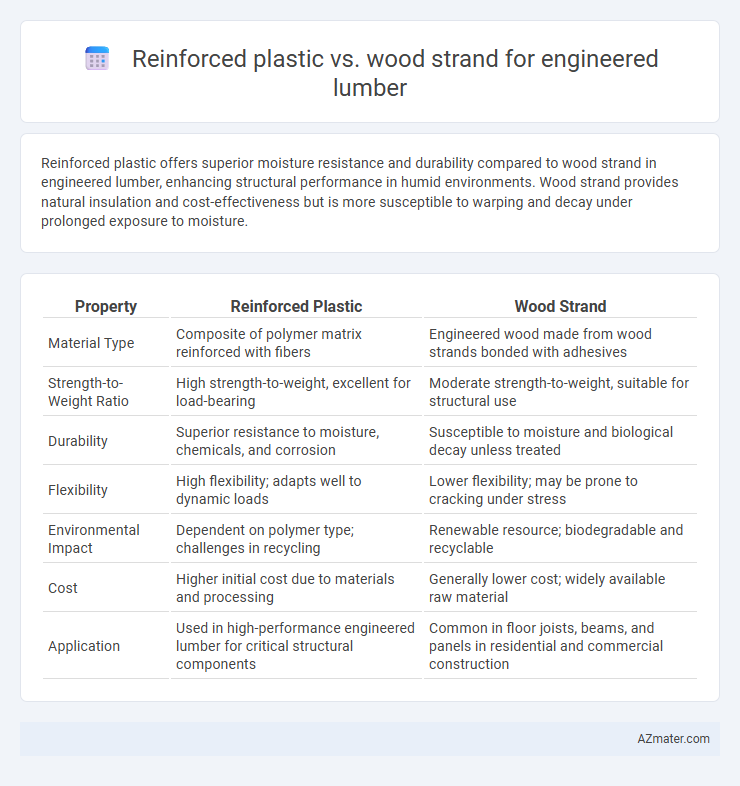Reinforced plastic offers superior moisture resistance and durability compared to wood strand in engineered lumber, enhancing structural performance in humid environments. Wood strand provides natural insulation and cost-effectiveness but is more susceptible to warping and decay under prolonged exposure to moisture.
Table of Comparison
| Property | Reinforced Plastic | Wood Strand |
|---|---|---|
| Material Type | Composite of polymer matrix reinforced with fibers | Engineered wood made from wood strands bonded with adhesives |
| Strength-to-Weight Ratio | High strength-to-weight, excellent for load-bearing | Moderate strength-to-weight, suitable for structural use |
| Durability | Superior resistance to moisture, chemicals, and corrosion | Susceptible to moisture and biological decay unless treated |
| Flexibility | High flexibility; adapts well to dynamic loads | Lower flexibility; may be prone to cracking under stress |
| Environmental Impact | Dependent on polymer type; challenges in recycling | Renewable resource; biodegradable and recyclable |
| Cost | Higher initial cost due to materials and processing | Generally lower cost; widely available raw material |
| Application | Used in high-performance engineered lumber for critical structural components | Common in floor joists, beams, and panels in residential and commercial construction |
Introduction to Engineered Lumber Materials
Engineered lumber materials include options like reinforced plastic and wood strand, each offering distinct structural benefits. Reinforced plastic provides high durability, moisture resistance, and consistent strength ideal for demanding applications. Wood strand, often used in oriented strand board (OSB), delivers cost-effective load-bearing capacity with optimized grain alignment for enhanced stability.
Overview of Reinforced Plastic in Construction
Reinforced plastic in engineered lumber combines high-strength fibers like glass or carbon with polymer matrices to create lightweight, durable, and moisture-resistant materials ideal for construction applications. This composite offers superior tensile strength, corrosion resistance, and dimensional stability compared to traditional wood strands, making it suitable for structural components subjected to harsh environmental conditions. Its versatility in molding and resistance to decay enhance the longevity and performance of engineered lumber in modern building projects.
Properties of Wood Strand in Engineered Lumber
Wood strand in engineered lumber exhibits high tensile strength and excellent dimensional stability, making it a preferred choice for structural applications. Its natural fibrous structure provides superior load-bearing capacity and resistance to bending compared to reinforced plastics. Moisture resistance and thermal insulation properties are enhanced through treatments, ensuring durability and performance in various environmental conditions.
Comparative Strength and Durability
Reinforced plastic in engineered lumber offers superior tensile strength and resistance to moisture, ensuring prolonged durability compared to wood strand composites, which tend to absorb water and degrade over time. Wood strand materials provide better natural flexibility and are more sustainable, but often require chemical treatments to enhance durability and prevent fungal decay. The choice between reinforced plastic and wood strand largely depends on the specific structural demands and environmental exposure conditions of the construction project.
Moisture Resistance and Environmental Performance
Reinforced plastic offers superior moisture resistance compared to wood strand in engineered lumber, reducing the risk of warping, swelling, and microbial growth. Engineered lumber with reinforced plastic components demonstrates enhanced durability in high-humidity environments, making it ideal for exterior and structural applications. From an environmental perspective, wood strand is renewable and biodegradable, whereas reinforced plastic may pose recycling challenges but extends product lifespan, potentially offsetting its environmental footprint.
Weight and Handling Differences
Reinforced plastic engineered lumber offers significantly reduced weight compared to wood strand products, enhancing ease of handling and transportation. Its lightweight composition decreases labor fatigue and increases installation efficiency on construction sites. Wood strand lumber, while heavier, provides greater rigidity but requires more careful handling due to its bulk and higher density.
Cost Analysis: Reinforced Plastic vs Wood Strand
Reinforced plastic engineered lumber typically incurs higher initial material costs compared to wood strand due to advanced polymer composites and manufacturing processes. Wood strand products benefit from lower raw material prices and established supply chains, resulting in more cost-effective production and installation. Despite higher upfront expenses, reinforced plastic offers enhanced durability and reduced maintenance costs, potentially offsetting price disparities over the lifecycle of engineered lumber applications.
Sustainability and Environmental Impact
Reinforced plastic engineered lumber offers superior durability and resistance to moisture, reducing the need for frequent replacement and lowering overall environmental footprints compared to wood strand products, which rely on harvested timber and contribute to deforestation. Wood strand lumber, while biodegradable and sourced from renewable forests, often involves significant energy consumption and chemical treatments impacting ecosystems and carbon emissions. Selecting reinforced plastic alternatives can enhance sustainability by utilizing recycled materials and promoting longer service life, mitigating resource depletion inherent in traditional wood strand manufacturing.
Applications in Modern Construction
Reinforced plastic offers superior moisture resistance and durability compared to wood strand, making it ideal for applications exposed to harsh environmental conditions in modern construction such as outdoor decking and structural panels. Wood strand engineered lumber excels in load-bearing components like beams and joists due to its high strength-to-weight ratio and sustainability from renewable sources. Both materials enhance structural performance, but reinforced plastic is favored in infrastructure requiring longevity and minimal maintenance, while wood strand remains popular for cost-effective residential and commercial framing.
Future Trends in Engineered Lumber Technologies
Reinforced plastic and wood strand materials are driving innovation in engineered lumber, with reinforced plastics enhancing durability and moisture resistance while wood strands offer sustainability and structural flexibility. Future trends emphasize hybrid composites combining these materials to optimize strength-to-weight ratios and environmental impact. Advances in bio-based resins and nanotechnology integration are expected to further elevate performance and market adoption of engineered lumber products.

Infographic: Reinforced plastic vs Wood strand for Engineered lumber
 azmater.com
azmater.com